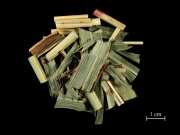Difference between revisions of "Kariyasu"
Jump to navigation
Jump to search
(username removed) |
|||
| (One intermediate revision by one other user not shown) | |||
| Line 8: | Line 8: | ||
kari yasu; kari yasa; | kari yasu; kari yasa; | ||
| − | == | + | ==Physical and Chemical Properties== |
ISO R105 Lightfastness Classification is about 2 (mordanted on alum) | ISO R105 Lightfastness Classification is about 2 (mordanted on alum) | ||
| − | == | + | ==Resources and Citations== |
| − | * ''Encyclopedia Britannica'', http://www.britannica.com Comment: Miscanthus" | + | * ''Encyclopedia Britannica'', http://www.britannica.com Comment: Miscanthus" [Accessed March 5, 2002]. |
* R.Feller, M.Curran, C.Bailie, 'Identification of Traditional Organic Colorants Employed in Japanese Prints and Determination of their Rates of Fading', ''Japanese Woodblock Prints'', Allen Memorial Art Museum, Oberlin College, Oberlin, 1984 | * R.Feller, M.Curran, C.Bailie, 'Identification of Traditional Organic Colorants Employed in Japanese Prints and Determination of their Rates of Fading', ''Japanese Woodblock Prints'', Allen Memorial Art Museum, Oberlin College, Oberlin, 1984 | ||
Latest revision as of 14:51, 21 September 2022
Description
The Japanese name for a traditional yellow colorant obtained from the Miscanthus tinctorius grass plant native to southeast Asia. The dye is primarily composed of anthraxin and related flavonoids.
Synonyms and Related Terms
kari yasu; kari yasa;
Physical and Chemical Properties
ISO R105 Lightfastness Classification is about 2 (mordanted on alum)
Resources and Citations
- Encyclopedia Britannica, http://www.britannica.com Comment: Miscanthus" [Accessed March 5, 2002].
- R.Feller, M.Curran, C.Bailie, 'Identification of Traditional Organic Colorants Employed in Japanese Prints and Determination of their Rates of Fading', Japanese Woodblock Prints, Allen Memorial Art Museum, Oberlin College, Oberlin, 1984
